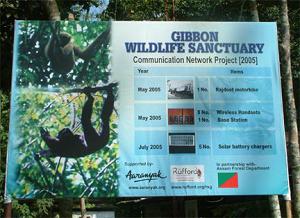Bibhuti Prasad Lahkar
Other projects
3 Feb 2008
Strengthening the Conservation Regime of Manas World Heritage Site through Community Participation
This project is intended to enhance capacity building of forest staffs to protect wildlife through in-kind support including sponsoring wireless equipment and motorbikes to assist anti-poaching staff detect and halt wildlife crime.

Gibbon Wildlife Sanctuary (GWS) is situated in eastern Assam (26º40’-26º45’N and 94º20’- 94º25”E) and is one important protected area in Indian for conservation of primate diversity. GWS harbours 7 species of primates out of Northeast Indian’s total 9 species. The following threatened species and their habitats in Gibbon Wildlife Sanctuary is being targeted for better protection – Hoolock Gibbon Bunipithecus hoolock (EN), Capped Langur Presbytis pileatus (EN), Pig-tailed Macaque Macaca nemestrina (VU), Stump-tailed Macaque Macaca arctoides (VU), Assamese Macaque Macaca assamensis (VU), Asian Elephant Elephas maximus (EN), Tiger Panthera tigris (EN) and Leopard Panthera pardus (VU). However, Bunipithecus hoolock and Elephas maximus has been identified as flagship species for the proposed project and conservation of Gibbon Wildlife Sanctuary.

The GWLS comprised of an area of 20.98 km2 and constituted in the year 1997. Being new protected area, it still lacks communication among forest camps for detection of wildlife crime and staffs are not trained on wildlife crime.
The frontline staffs of the sanctuary are lacking the basic knowledge on wildlife crime, its detection and investigation as well as the legal procedures to follow any case. There is one old model Jeep (vehicle) which is not in running condition. As such the anti-poaching staffs, takes time to detect wildlife crime. There are four wireless handsets which need recharging. But as there is no electricity in the interior camps charging of wireless batteries has become a major problem. There are about 15-35 elephants in the sanctuary and some of the tuskers are very big, and hardly seen in other parts of Assam. To protect this unique area for endangered species, it is necessary to train the frontline staff and to provide them the communication facilities for strengthening the protection to the sanctuary.